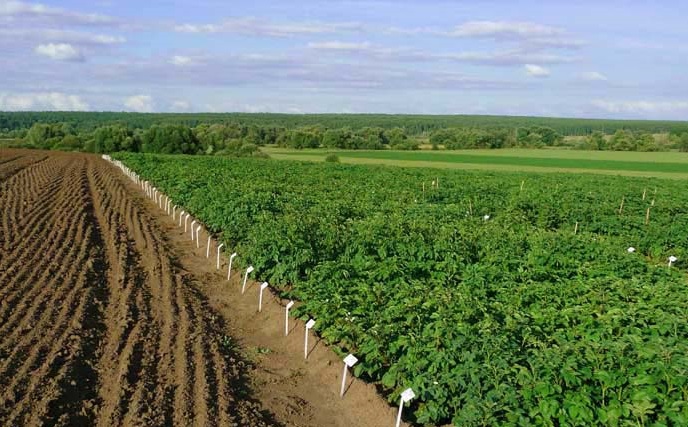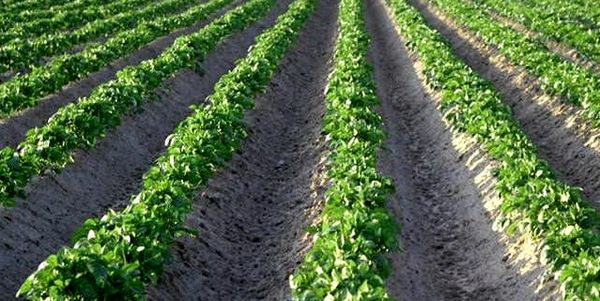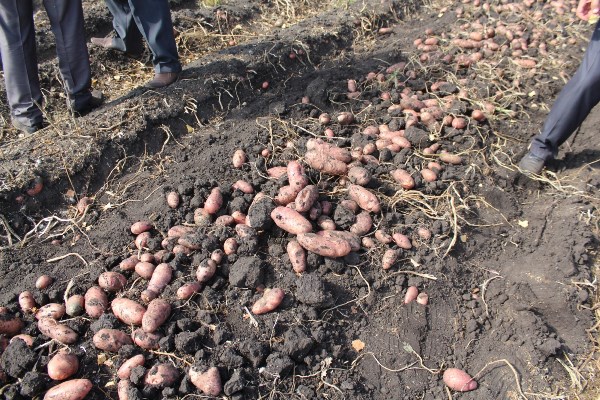Potato cultivation technology on a farm
Content
Site selection and soil cultivation
All potato varieties cultivated in Russia require a properly selected growing area to obtain a good harvest. It is this parameter that largely determines the size of the crop (seed and ordinary), as well as its quality.
The cultivation of potatoes takes place in an area that is well protected from the northerly winds. The slope from the south-west, south and south-east sides should act as protection. From the soil, sandy loam or sandy ones are best suited. The primer should be light and dark in color. In this case, the thermal regime is improved. In addition, the site should be well lit throughout the day.
Potato cultivation always starts with soil preparation. Tillage begins in April (in the second half) and early May. This will enable early landing. All potato varieties require the creation of a loose, powerful and moist soil layer. This is essential for growing, especially seed potatoes.
The area for potatoes must be dug twice. In autumn, digging is carried out on a shovel bayonet, after which fertilizers are applied. This minimizes the risk of disease. Also, for this, it is necessary to remove all plant residues from the site. If potatoes are grown on this site for the second year, then the autumn digging is not carried out, but simply the site is cleared of plant residues.
In the spring, digging is done to accumulate moisture in it. For this purpose, the soil is loosened a little with a rake. For light soils, digging to a depth of 14 cm is permissible, for heavy and medium - up to 20 cm. In the presence of heavy soils, organic fertilizers must be applied. This completes the preparation of the site.
Ridge technology
Today there are several technologies for growing this vegetable. Ridge-based potato cultivation technology is especially popular today, as it improves soil aeration. Differs in advantages when planting potatoes on loamy or clay soil. It is especially effective in humid growing conditions. But for the more arid regions of our country, a smooth landing is used. Many varieties of potatoes cultivated in Russia are grown using this technology.
Ridge technology involves three types of cutting:
- autumn. Used for planting early potato varieties. Such cutting is organized in plain fields. It is held at the end of October. This will reduce soil subsidence. A week before cutting, it is necessary to loosen the soil. Ridges are cut by 6 or 8 row cultivators;
- spring. This type of cutting is often used in moisture-rich areas for gray forest and sod-podzolic soils. Ridges are cut according to the same principle as in autumn;
- in the process of planting.
The use of ridge planting technology makes it possible to qualitatively loosen the soil and almost completely destroy the weeds even before the first shoots of potatoes appear.
How to fertilize
To obtain quality seed and regular potatoes, planting must be fertilized.Many gardeners do not always know how to fertilize potatoes. For this plant, you can use fertilizers of the following types:
- fresh manure. However, remember that it can lead to a deterioration in the taste of the crop;
- peat, if applied in its pure form, does not affect the yield. The only exception is peat, which contains a lot of vivianite;
- compost. The most optimal type of fertilizer, especially if it contains peat and manure in equal proportions. It is not recommended to use chicken manure and fresh manure, as this can lead to infection of the potatoes with scab. But if you add peat to it, then it can be used in the garden.
Also for potatoes, you can use mineral fertilizers or low-value manure. The main thing here is to correctly observe the proportions in the preparation of fertilizers.
Cooking tubers for planting
The most crucial moment in growing potatoes (especially seed) is the preparation of tubers. The quality and abundance of the crop directly depends on this.
The preparation of tubers requires a bulkhead of the planting material. Here, defective tubers, affected by diseases, with a dry or wet putrefactive structure, should be selected. Also, small and ugly tubers, as well as too large ones, are not used for planting. It is these tubers that give a low-quality and low yield. Planting material must be carefully selected, leaving only beautiful, healthy and medium-sized tubers, which, with proper care, will allow you to get a high-quality and bountiful harvest.
Video "Planting potatoes on a farm"
Landing
Planting potatoes is possible in three ways:
- ridge technology;
- smooth fit;
- trench landing.
Each of the planting methods is suitable for specific situations. Arbitrary choice of the method of planting tubers can lead to negative results and, as a result, a low yield level.
But all of these methods have a few things in common:
- the landing location should be done on the south side, towards the north. This will create uniform lighting conditions for plants;
- compliance with the proper distance between adjacent plants and beds;
- fertilization. Usually, at the time of planting, compost and ash are added from fertilizers.
In addition, for better germination in trenches or holes, it is good to add onion skins. It will protect plants from the main pest - the Colorado potato beetle.
The distance between adjacent tubers should be:
- for late varieties - 70 cm;
- for early varieties - 60 cm.
The distance between the rows must be:
- for late varieties - about 26-30 cm;
- for early varieties - about 31-35 cm.
These distances are given for tubers that are of standard size (about the size of a hen's egg). If the tubers are smaller, then the distance between them and the rows decreases proportionally.
The optimum planting depth is determined by the type of soil:
- for loamy and heavy soils - 8-10 cm;
- for clay soils - 4-5 cm;
- for light soils - 10-12 cm.
These parameters are also equated to the standardized size. Therefore, if the tubers are shallow, the depth must be reduced. But experts do not recommend deviating more than 3 cm.
Care
After the potatoes have been planted, the plants must be properly monitored. All varieties of potatoes cultivated in Russia differ in rather similar conditions of care. Deviations from the general cultivation scheme are characteristic only for some varieties.
Planting care involves the following actions:
- loosening the soil. For an excellent harvest, the soil under the potato bushes must be moist and loose. Dryness of the soil is contraindicated, but you do not need to fill in the plants, otherwise the tubers will begin to rot;
- hilling must be carried out after each watering. Hilling should be done in the early morning or evening.For the first time, hilling is carried out when the bushes reach 12-15 cm, and the second time - after 20 days;
- laying drainage to ensure the necessary soil moisture;
- timely feeding. It is held for the first time one month after landing. The second time - after the appearance of buds, and the third - after the end of flowering.
Please note that watering of potatoes is organized depending on weather conditions, land condition and growing region. During one season, only three waterings may be enough:
- the first - after the emergence of shoots;
- the second - when the first buds appear;
- the third - after flowering.
Such care will allow you to get an excellent harvest. Follow the above rules and your potatoes will definitely grow tasty and large.
Pest control
To protect potatoes from pests, the following preventive actions must be taken:
- autumn and spring deep digging of the soil;
- collecting larvae, beetles and their pupae from plants;
- ensuring timely feeding;
- planting early varieties of tubers on the site, which have already sprouted;
- introduction of onion peel into the wells.
When pests are detected on plants, it is necessary to treat them with special ecological or chemical solutions.
Compliance with the rules of planting, cultivation, care and preventive measures will allow you to minimize the risk of getting a poor-quality crop. To top it all off, a properly selected growing area will allow you to grow a high-quality potato crop with minimal physical costs, which will be perfectly stored.
Video "Potato growing technology"
From the video you will learn everything you can about the process of growing this crop. The video will be useful for both farmers and gardeners.






